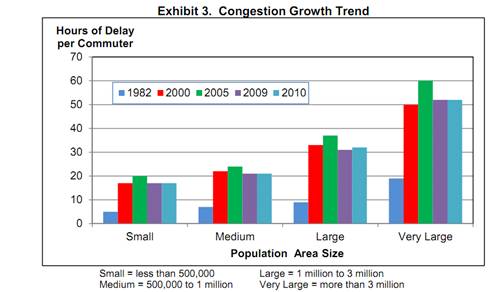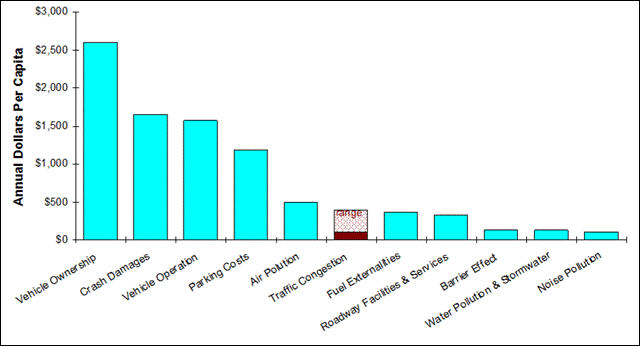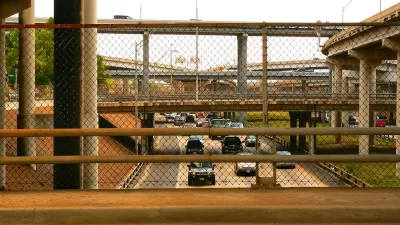The annual Urban Mobility Report (UMR), published by Texas Transportation Institute (TTI), should come with a warning label.

[This article was originally posted on October 1, 2011]
Once again the Texas Transportation Institute (TTI) published its annual Urban Mobility Report (UMR), and once again I feel obliged to warn planners that it is based on faulty assumptions and biased analysis methods. This is not to deny that traffic congestion is a significant problem, but the UMR significantly exaggerates its importance compared with other transport costs and exaggerates roadway expansion benefits.
The report's major errors and biases are summarized below. For more information, see my recent study, "Smart Congestion Relief: Comprehensive Analysis Of Traffic Congestion Costs and Congestion Reduction Benefits," and Joe Cortright's report, "Driven Apart: How Sprawl is Lengthening Our Commutes and Why Misleading Mobility Measures are Making Things Worse." For even more detailed information, see Grant-Muller and Laird's "International Literature Review of the Costs of Road Traffic Congestion."
- The UMR primarily measures congestion intensity, that is, the percentage reduction in travel speeds when people drive during peak periods. This methodology ignores the congestion avoided when travelers shift mode (for example, to grade-separated public transport) or choose closer destinations (for example, due to more compact development patterns). It even implies that congestion declines if uncongested vehicle travel increases (for example, due to sprawled development) because congested miles are divided by more total vehicle miles. A better indicator is per capita congestion costs, which indicates total congestion costs to individuals and the economy. Cities with high quality public transit and compact development, such as New York and Chicago, tend to have higher congestion intensity but lower per capita congestion costs than more automobile-dependent, sprawled cities such as Los Angeles and Houston (Aftabuzzaman, Currie and Sarvi 2010; Litman 2004), a benefit the UMR ignores.
- It uses the term commuter when it actually means peak-period motorists. This reflects the TTI's bias in favor of automobile travel and its tendency to ignore other modes.
- It uses roadway level-of-service (LOS) A (freeflow traffic) as a baseline. Most economists recommend a more realistic baseline, such as roadway LOS C (i.e., a moderate level of congestion), which maximizes traffic volumes and therefore economic efficiency (Litman 2009; Transport Canada 2006). This exaggerates the UMR's estimated congestion costs.
- It ignores the tendency of congestion to maintain equilibrium. Traffic volumes grow to the point that congestion delays constrain further peak-period vehicle trips, causing travelers to shift to alternative times, routes and mode, and forego lower-value trips. For example, when roads are congested, you might choose a closer destination or defer a trip until later, but if congestion is reduced, you make those peak-period trips. As a result, congestion does not usually increase as much as would be predicted by extrapolating past trends, and roadway expansion provides little long-term congestion relief.
- It claims that traffic congestion problems are getting worse and will continue to grow into the future, although its own analysis actually indicates that congestion declined after 2005 (see the report's Exhibit 3, copied below). This is unsurprising, since U.S. vehicle travel peaked in 2003, and contrary to the UMR's assumptions, there is no evidence that total vehicle travel will grow significantly in the future, due to demographic and economic trends that are reducing per capita vehicle travel in the United States and other developed countries (Litman 2006; Peak Car; Polzin, Chu and McGuckin 2011).

- It uses an excessive ($16 per hour, although $8 per hour is quoted on page 20) value for personal travel time costs. In practice, most motorists are unwilling to pay that amount for marginal travel time savings. This exaggerates the UMR's monetized (measured in monetary values) congestion cost estimates.
- It claims that roadway expansion can provide significant congestion reductions and economic benefits, although in practice, roadway expansion does little to reduce long-term congestion, and by inducing additional vehicle travel it tends to increase other traffic problems. FHWA research indicates that the economic return on roadway expansion projects has declined during the last few decades (Mamuneas and Nadiri 2006).
- Although it recognizes the ability of public transit to reduce traffic congestion, it uses a simplistic analysis methodology (it calculates the additional congestion if all transit users shifted to driving) that fails to account for service quality factors. Grade-separated public transit (trains or buses in their own rights-of-way) tends to reduce roadway traffic congestion, but conventional bus service does not. Winston and Langer found that congestion declines in cities as rail transit mileage expands but increases as bus transit mileage expands, apparently because buses attract fewer motorists, contribute to congestion, and do little to increase land use accessibility.
The TTI report reflects the old transport planning paradigm, which assumes that transportation means driving, so transportation problem means a constraint on driving, and transportation improvement means easier and faster driving. The new paradigm recognizes that driving is just on form of transport, there are many types of transport problems, and there are many ways to improve transport. Even using the TTI's own estimate that U.S. urban traffic congestion costs $101 billion annually, congestion ranks as a moderate cost overall, far less than vehicle, accident, and parking subsidy costs, and about equal to pollution costs. This means, for example, that it would be economically inefficient to implement a strategy that reduced congestion by 20 percent if doing so increases total vehicle expenses, crash damages or parking costs by just 5 percent, but a congestion reduction strategy becomes far more cost effective if it provides even modest reductions in these other costs.

These criticisms have been raised in previous years by myself, economist Joe Cortright, and others. If the UMR was a serious study it would include detailed discussion of these criticisms. Ignoring these issues indicates that TTI willingly promotes inaccurate analysis and ignores other perspectives.
For more information see:
Md Aftabuzzaman, Graham Currie and Majid Sarvi (2010), "Evaluating the Congestion Relief Impacts of Public Transport in Monetary Terms," Journal of Public Transportation, Vol. 13, No. 1, pp. 1-24; at www.nctr.usf.edu/jpt/pdf/JPT13-1.pdf. Also see, "Exploring The Underlying Dimensions Of Elements Affecting Traffic Congestion Relief Impact Of Transit," Cities, Vol. 28, Is. 1 (www.sciencedirect.com/science/journal/02642751), February 2011, Pages 36-44.
Robert L. Bertini (2005), You Are the Traffic Jam: An Examination of Congestion Measures, Department of Civil & Environmental Engineering, Portland State University, TRB Annual Meeting (www.trb.org); at www.its.pdx.edu/pdf/congestion_trb.pdf.
Joe Cortright (2010), Driven Apart: How Sprawl is Lengthening Our Commutes and Why Misleading Mobility Measures are Making Things Worse, CEOs for Cities (www.ceosforcities.org); at www.ceosforcities.org/work/driven-apart.
Susan Grant-Muller and James Laird (2007), International Literature Review of the Costs of Road Traffic Congestion, Scottish Executive (www.scotland.gov.uk); at www.scotland.gov.uk/Publications/2006/11/01103351/0.
Todd Litman (2001), "Generated Traffic; Implications for Transport Planning," ITE Journal, Vol. 71, No. 4, Institute of Transportation Engineers (www.ite.org), April, pp. 38-47; at www.vtpi.org/gentraf.pdf.
Todd Litman (2004), Rail Transit In America: Comprehensive Evaluation of Benefits, Victoria Transport Policy Institute (www.vtpi.org); at www.vtpi.org/railben.pdf.
Todd Litman (2006), The Future Isn't What It Used To Be: Changing Trends And Their Implications For Transport Planning, Victoria Transport Policy Institute (www.vtpi.org); at www.vtpi.org/future.pdf; originally published as "Changing Travel Demand: Implications for Transport Planning," ITE Journal, Vol. 76, No. 9, (www.ite.org), September, pp. 27-33.
Todd Litman (2009), "Congestion Costs," Transportation Cost and Benefit Analysis, Victoria Transport Policy Institute (www.vtpi.org/tca).
Todd Litman (2011), Smart Congestion Relief: Comprehensive Analysis Of Traffic Congestion Costs and Congestion Reduction Benefits, VTPI (www.vtpi.org); at www.vtpi.org/cong_relief.pdf.
Theofanis Mamuneas and Ishaq Nadiri (2006), "Production, Consumption and Rates of Return to Highway Infrastructure Capital," at http://editorialexpress.com/cgi-bin/conference/download.cgi?db_name=IIPF62&paper_id=11.
Nelson\Nygaard (2006), Traffic Reduction Strategies Study, Report and various appendices, City of Pasadena (www.cityofpasadena.net); at www.cityofpasadena.net/councilagendas/2007%20agendas/Feb_26_07/Pasadena%20Traffic%20Reduction%20Strategies%2011-20-06%20DRAFT.pdf.
Transport Canada (2006), The Cost Of Urban Congestion In Canada, Transport Canada (www.tc.gc.ca); at www.tc.gc.ca/pol/en/acs/EconomicAnalysis/docs/summary.pdf.
TTI (annual reports), Urban Mobility Study, Texas Transportation Institute (http://mobility.tamu.edu/ums).

Maui's Vacation Rental Debate Turns Ugly
Verbal attacks, misinformation campaigns and fistfights plague a high-stakes debate to convert thousands of vacation rentals into long-term housing.

Planetizen Federal Action Tracker
A weekly monitor of how Trump’s orders and actions are impacting planners and planning in America.

In Urban Planning, AI Prompting Could be the New Design Thinking
Creativity has long been key to great urban design. What if we see AI as our new creative partner?

King County Supportive Housing Program Offers Hope for Unhoused Residents
The county is taking a ‘Housing First’ approach that prioritizes getting people into housing, then offering wraparound supportive services.

Researchers Use AI to Get Clearer Picture of US Housing
Analysts are using artificial intelligence to supercharge their research by allowing them to comb through data faster. Though these AI tools can be error prone, they save time and housing researchers are optimistic about the future.

Making Shared Micromobility More Inclusive
Cities and shared mobility system operators can do more to include people with disabilities in planning and operations, per a new report.
Urban Design for Planners 1: Software Tools
This six-course series explores essential urban design concepts using open source software and equips planners with the tools they need to participate fully in the urban design process.
Planning for Universal Design
Learn the tools for implementing Universal Design in planning regulations.
planning NEXT
Appalachian Highlands Housing Partners
Mpact (founded as Rail~Volution)
City of Camden Redevelopment Agency
City of Astoria
City of Portland
City of Laramie




























